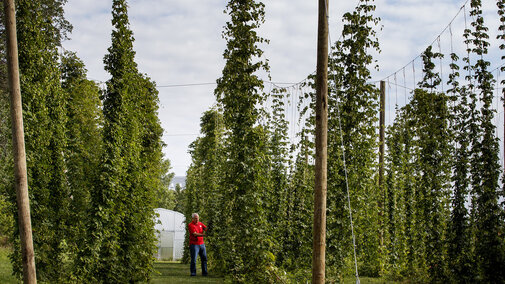From field and lab to brew kettle and marketplace, research from the University of Nebraska–Lincoln is helping further the Cornhusker State’s burgeoning craft brewing industry.

In the field, Nebraska’s Stacy Adams is leading the charge, guiding a multi-year study to see if hops can be grown locally and if the resulting pinecone-like blooms are viable as a niche revenue crop for producers. The work is funded through a grant from the Nebraska Department of Agriculture.
“The big news is that we’ve shown popular varieties of hops can be grown in Nebraska and that they can hit important production targets,” said Adams, associate professor of practice in agronomy and horticulture. “The next step is to see if Nebraska-grown hops can, from year to year, consistently hit those targets that are important to craft brewers.”
Launched in summer 2016, the Nebraska Hops project is testing the viability of eight hop varieties at five locations statewide. The plants are a perennial that sprout fast-growing bines and produce small cones that, when properly dried, add flavor to and provide a stabilizing agent in beer production. Hops are also used in the floral industry and for making pharmaceutical products.
Zeus, a hop with an aroma profile that is spicy and herbal, has been the most consistent in hitting key production targets — including the number of blooms harvested and the levels of alpha and beta acids, which provide much sought-after bitter flavors. Other varieties showing promise after the 2017 growing season (the project’s first full production year) are Chinook, Cluster, Crystal and Willamette.
“The numbers we are seeing in those five varieties look really good,” Adams said. “Our plot in the Panhandle has actually been the most promising, where all the key targets on all hop varieties grown have been remarkably higher.”
Other initial findings in the ongoing study show that the bines are resilient to damage from thunderstorms, disease issues and pests.
Adams is currently working on a publication that will outline strategies on how to produce hops on a small parcel of land. The goal of the publication is to offer Nebraska producers the necessary information — from growing needs to equipment investments — to determine if they can grow hops for profit as an alternative crop.
“We’ve received a number of phone calls from people in Nebraska and surrounding states who are interested in hops production,” Adams said. “It’s the new, cool, hip thing to grow.”
To help meet demand for information on hop production, Nebraska Extension added Katie Kreuser as its hop program coordinator in April. She is tasked with providing details about university research on the specialty crop to Nebraska hop growers, industry representatives and the public.
Kreuser answers questions from growers daily, coordinates workshops and other educational events, and communicates about hops through social media accounts and the Nebraska Bine Times blog.
The hop study and Kreuser's outreach work are supported by Annette and Bruce Wiles, who have launched a hop-growing operation near Plattsmouth. The Wileses have provided funding for hops trellis systems, cultivar research, and lab testing services in the Department of Agronomy and Horticulture. Their financial contributions helped organize a Nebraska Extension grower survey that led to Kreuser's position and helped establish the first Nebraska Grower and Brewer Conference. Read more about the Wileses support.
Nebraska’s craft brewing-related research in the lab was well represented at the Nebraska Grower and Brewer Conference. The second-annual event, held Jan. 18-19 in Omaha, was organized by Nebraska Extension.
Featured topics at the conference included Keenan Amundsen’s work into learning more about hops that grow wild across Nebraska. Amundsen presented on the topic with Megan Franklin, a student worker in agronomy and horticulture.
“These are hops that spilled out when settlers were going across the nation,” Adams said. “Keenan is examining the genetics of these hops, looking for indications if they evolved in ways that make them uniquely suited to grow and produce in conditions in Nebraska.”
Ultimately, Amundsen's study may lead to the discovery of a new hop variety and/or a plant that can be used to meet brewing industry production needs.
Additional Nebraska faculty and topics they presented at the conference include:
- Stephen Baenziger, a nationally-recognized expert on small grains breeding and genetics, discussed production of barley, the most common cereal grain used in the brewing process;
- Kyle Broderick, an assistant extension education in plant pathology, talked about hop diseases and how to manage them;
- Adams presented on the quality and productivity of hop bines grown in Nebraska;
- Bob Hutkins, a professor in food science and technology, and biological sciences, provided an overview of lab testing services available at the university; and
- Changmou Xu, a research assistant professor in the Food Processing Center, showcased findings in a study of hop tissue and oil analysis.
Nebraska brewers are excited to have the university helping lead the charge in experimentation in hops production and providing expertise in other areas of the field.
“The university is in the best position to lead research into working with different varieties of hops and educating growers and brewers,” said Marcus Powers, co-founder and chief of operations for Zipline Brewing Company.
Based on figures from 2016 (the most recent available) craft brewing in Nebraska has direct economic impacts that include nearly 9,000 jobs and more than $235 million in wages. The industry, also in 2016, generated more than $80 million in state and local taxes. The total economic impact of craft brewing in Nebraska is $465 million.
Additional headlines related to the University of Nebraska–Lincoln’s impact on the craft brewing industry include:

